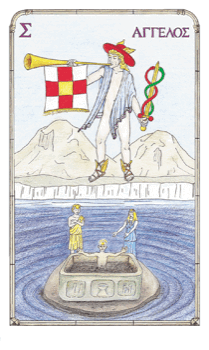
In the midst of the "wine-dark sea," a large bronze sarcophagus, green with verdigris, stands on a small patch of dry ground. On the distant horizon a twin-peaked mountain rises above white cliffs descending to the water.
Standing behind the sarcophagus are two figures facing toward us; on our left a ruddy man wears a solar crown and a yellow workman's khiton (tunic), on our right a pale woman wears a lunar crown and a blue peplos (long robe). They are adoring a naked child (of indeterminate sex), visible from the waist up, who stands facing us in the sarcophagus. He has golden mark on his forehead. The man's arms are crossed on his chest, the woman's reach out to the child.
Note that Latin angelus is a late formation (from Greek angelos, messenger or envoy) used only in a Christian context; in classical Latin nuntius has approximately the same meaning as Greek angelos (Smith's Eng.-Lat. Dict. s.vv. angel, messenger). Hermes is, of course, the archetypal angelos. Indeed the tarot angel is sometimes identified with St. Michael, who in Christian tradition blows the trumpet to call the souls on Judgement Day. Michael is associated with planet Mercury, and hence with Hermes Psychopompos, or Guide of Souls. (Sharman-Burke 114)
In the Ferrara order 19.Angel occupies the ninth position in its Hendecad, and the primary Pythagorean meaning of Nine is "That which Brings Completion"; it is "Near Perfection" and the "Threshold of the Return to Unity." (See the Nines in the Minor Arcana.) This is confirmed by isopsephia, for ERMHS O AGGELOS (Hermes Ho Angelos, Hermes The "Angel," i.e. Messenger) = 735, which reduces to 5-3+7 = 9. However, Iris is also called Angelos (Kerenyi, GG 60) and H IRIS (He Iris, Iris) = 328, which reduces to 8-2+3 = 9, so we see that this trump corresponds to the unification of Hermes Psychopompos (1.Magician) and Iris Psychopompos (7.Temperance), two principal agents of transformation.
As 1.Magician Hermes began the process of transformation represented by the sequence of trumps (intervening critically as 6.Eros); now at the end he steps in again as Psychopompos, to lead the soul to its final destination. (Thus we see him using his wand to raise a soul from an urn on a 6th cent. BCE lekythos, Bonnefoy, GEM 187.) He is the Emissary of Hades, who touches the eyes of the dead with his golden wand and guides their souls to the underworld. (Pollack I.122; SB&G 78)
But Hermes' golden wand can open the eyes as well as close them (Kerenyi, GG 247). Not only does Hermes lead souls to the Underworld, he also shows them the way back, and so he is the Redeemer, who rescues souls from death, and the Deliverer, who raises the dead from the Underworld. (Nichols 346; SB&G 79)
For example, after Semele was incinerated by the divine fire of Zeus, the unborn Dionysos was incubated in Zeus's thigh. After he was born, he was given to Ino (Semele's sister) and Athamas to be raised as a girl. After Hera drove them mad, Hermes took Dionysos away to Mount Nusa (from which some derive his name, Dio-Nusos) to be raised by the nymphs. (Thus we see Hermes and Dionysos in the famous statue by Praxiteles.) (Kerenyi, GG 257-8)
In another typical myth of shamanic regeneration, Tantalos, who had tasted the nectar and ambrosia of the gods, caused his son Pelops to be cut up, boiled in a purifying cauldron and served to the gods at a feast (eranos). In some versions Hermes reassembles the boy - except for his left shoulder, eaten by Demeter, which is replaced by an ivory one. This is also typically shamanic: an incorporation of the spirit world, hence the gold forehead (over the Third Eye) of the child in 19.Angel. Psychologically, the psyche is disassembled into its components and reassembled, but incorporating an element of divinity. (In other versions of the myth Pelops is restored by Rhea, that is, by 16.Star, Lady of Necessity, who is responsible for the transformations represented by trumps 17-20; see 16.Star.) (Butterworth, Traces ch. 4; Gantz 531-6)
In further illustration Sharman-Burke and Greene (79) observe that Hermes led Theseus and Orpheus out of the Underworld, but he does not perform this service in the version of the myths that I know (e.g. Gantz 291-5, 721-5). However, he does lead Euridice to Orpheus before their ascent, and back again, after the tragic retrospective glance.
In 19.Angel Hermes is a redeemer, but redemption means getting back something of one's own. In this case what we are getting back is the integrated Self - that which is most truly ours, though we may have never possessed it before. This new order, which will be attained in 21.World, is accomplished by balancing on several levels, which is accomplished in 20.Justice. (Nichols 338, 344)
First, the four functions of consciousness (thinking, sensing, feeling and intuition) must be brought into harmony. On this trump they are represented by the four human figures (rather than elements, liquids, metals, etc.) to show that the functions have become humanized. The superior function (which may be any one of the four), the function most developed in an individual, is represented by Hermes hovering above. The inferior function (which is opposite to the superior: thinking and feeling are opposites, as are sensation and intuition) is the least developed and is represented by the child, who is the major vehicle for regeneration. The secondary functions are represented by the man and woman. All four must be reunited to create the Homo Philosophicus. (Gad 295; Nichols 338-9, 347)
Second, the four figures represent the totality of the psyche, the various components (e.g., consciousness, anima, animus, shadow), which must be integrated. The unification of opposites is represented by the figures of the woman, who reaches out actively, and of the man, who adores the child passively. Their gestures also represent a reversal of the mundane order, and thus the inauguration of a new order in the cosmos. (Case 201)
Finally, the androgynous child represents the reintegration of the parents (the boy and girl, now mature, from 18.Sun), who is summoned by Hermes into an Unio Mystica. That is, by integrating the elements of the psyche into the Self, we reunite with the Unus Mundus, which is the source of the Self. The resurrected child possesses the "corpus glorificationis, the 'subtle body,' in the state of incorruptibility" (Jung, ACU 202), the Diamond Body of Chinese alchemy. In this way 0.Idiot, who began his journey guided by luck and intuition, is led by divine intervention (19.Angel) into its last stages, where the experiences of his journey are synthesized (20.Justice) into a new cosmos (21.World). (Case 201; Gad 297-300; Haitch 154; O'Neill 390; cf. Pollack I.102, 122; SB&G 78-9; Simon 52)
In Christian tradition angels are considered sexless, and here also we have found the divine messengers to be somewhat androgynous (see 1.Magician and 7.Temperance). Ritual transvestism is also common among shamans, since they travel across the boundaries between the worlds. In 19.Angel, however, there is an additional factor, for the psyche is travelling toward the Unio Mystica (Mystical Union), in which all the opposites are united. Thus, after the polarity of 17.Moon and 18.Sun, the last three trumps are progressively more androgynous: androgynous male (19.Angel), androgynous female (20.Justice), and purely androgynous (21.World).
In summary, Hermes Psychopompos is an agent of rebirth. In psychological terms he awakens us to a new life on earth, achieved through a new consciousness and an enlarged personality, and to the enlarged responsibilities that come with a more developed psyche. The child represents Dionysos (also represented by 0.Fool) and all the resurrected gods (Adonis, Attis, Mithras, Osiris, etc.); his death began in 0.Fool, he is reborn in 21.World. (Nichols 337, 345; Pollack I.122; SB&G 79; Williams 126)
The salpinx is a long, straight war-trumpet (Guhl & Koner 209-10), and metal trumpets, such as the salpinx, are associated with the elements fire and water - the two primary opposites (sulphur and mercury, sun and moon), and thus represent the Coniunctio Oppositorum that must be achieved in 20.Justice. It also corresponds to the "twin peaked Mountain of Mars," which we see in the background of 19.Angel. (Cirlot s.v. trumpet; for more on the mountain see 7.Temperance, 17.Moon and 18.Sun)
The legends of the Trojan War say that Achilles' mother, worried for his safety, dressed him as a girl and hid him among the women in Lukomedes' palace. He was discovered by Odysseus and Diomedes, who sounded the salpinx, for Achilles automatically grabbed weapons, since he could not ignore this summons. (Apollodorus, Bibl. III.xiii.8; Gantz 581; Hyginus, Fab. 96)
So also in this trump: the primitive, penetrating sound of the salpinx represents the Call, the summons that cannot be ignored. For Achilles it was the call to leave his mother's protection and take on adult responsibilities. Such a call may come from inside or outside, but in either case it summons us to advance in our development; if we ignore it, we sink back into stagnation, and are perhaps never called again. (Nichols 337-8, 345; Pollack II.120-1, 123; Williams 127)
Walker (129) compares the trumpet of 19.Angel with the Gjallarhorn, which, in Scandinavian mythology, Heimdall, the Watchman of Heaven, will sound to awaken the gods and summon them to Ragnarok, the final battle (Bellows 12n27). In the Poetic Edda (Voluspo 46, tr. Bellows, p. 20) we read:
Heimdall has many connections with the sea. First, the "Sons of Mim" mentioned above are water spirits. Heimdall was born of nine maiden sisters (Ocean goddesses), nine being the number of this trump in the Hendecad. Walker (130) claims that his name means "Son of the Sea Mother." In any case, he has numerous connections with the sea, which appears in this trump (as in other tarots, including Case's BOTA deck, the Golden Dawn deck, and perhaps the Wirth and Marseilles decks). This is the briny primeval Ocean which surrounds the world, the sea of the High Priestess and High Priest; it is also the salty Womb of Rebirth from which new life arises; it is the source of the libido which engenders life (see 16.Star and 17.Moon). (Bellows 20n46; Case 201; Nichols 348)
In the Pythagorean tarot the reborn child is in a sarcophagus, which means "flesh eater," for the first sarcophagi were made from a special Trojan limestone that dissolved the flesh of corpses. Thus the sarcophagus represents the dissolution (Solve) of the old life, which has been accomplished by the preceding trumps. However, the sarcophagus is also an arc in the midst of Ocean, for in Latin an arca is a box, including a coffin, or a coffer holding hidden treasure; from it we get "arcana" for the secrets hidden in the arca. This is the Apocalypse (Uncovering), for the Arcanum is revealed: the Mysterium Coniunctionis of the Moon and Sun (trumps 17, 18) has produced the Homunculus emerging from the Hermetic Vessel (trump 19). (Case 201; Gad 301; LSJ s.v. sarkophagos; O'Neil 286, 390)
The sarcophagus also represents the bronze cauldron (aes cavum) of rebirth, which appears in many myths; we have already considered the resurrection of Pelops (see also 7.Temperance and 16.Star). Another myth reflecting a shamanic regeneration has Dionysos being torn apart by the Titans and boiled in a cauldron, after which everything was incinerated by a blast from Zeus (dissolution of the psyche). Zeus and Athena rescued the ashes (purified prima materia, foliated earth, sublimated matter), from which a potion was brewed, which Semele drank and became pregnant (with Dionysos Reborn). Similarly, Ino (sister of Semele) seethed her boy Melikertes in a cauldron, and on an ancient black-figure vase we see a child emerging from a tripod cauldron, which is flanked by two men and two women. However, this regeneration was unsuccessful, and the mother and child returned to the sea. The well-known story of Medea and Pelias also recounts an unsuccessful (or intentionally aborted) regeneration. On the other hand, Medea successfully dismembered and regenerated Iason (Jason) and his father Aison, although in these cases she uses a lebes (cauldron) of gold. (Edinger 123; Gantz 365-8; Kerenyi, GG 254-7, 263-5) (In 19.Angel the adults wear robes, as in several ancient vase paintings of Medea and either Pelias or Iason.)
Pausanias (V.17.10-19.7) describes the famous cedar Chest (Larnax) of Kupselos, in which the babe Kupselos was hidden by his mother. The sides of the chest depict Pelops, Medea, Iason at the funeral games of Pelias, and Dionysos in a cave, as well as Circe lying with Odysseus, Eriphule with the necklace of Harmonia (see 14.Devil), two "unnamed women skilled in medicine lore" grinding herbs, and many other scenes from mythology.
The primordial couple floating in an arc on the cosmic womb represent the seeds of the next creation. Thus, on an ancient Day of Judgement, Zeus decided to destroy the corrupt world, and after blasting it with his bolt (15.Tower), called on Poseidon to flood the land. Only Deukalion and Purrha survived, in a chest (Gk. larnax = Lat. arca), and they sowed the seeds of a new, better race of people; the seeds were stones, the "bones of Mother Earth." In Apollodorus' account (Bibl. I.vii.2), the arc floated for nine days and nights, nine being the number of 19.Angel in its Hendecad. Further, it was Hermes who heralded the end of the rain and directed this act of (re)creation. (Gantz 165; Walker 130)
Mythology contains many stories of people set afloat in boxes. Often, it is the mother and her baby: Danae and Perseus, Semele and Dionysos, Auge and Telephos, Rhoio pregnant with Anios. In other cases it is twins (Romulus and Remus), or brother and sister (Tennes and Hemithea). And, of course, there is Noah's Arc. Nonfloating chests are also used for the incubation of various magical children, including Adonis (the yearly resurrected lover of Aphrodite) and Erikhthonios (Hephaistos' son, Athena's serpent-child, the first king of Athens), whom the Kodros painter depicts being born from the womb of Gaia and delivered to Athena (20.Justice) while Hephaistos, Herse (Dew, see 17.Moon) and her father Kekrops look on. The myth of Osiris also fits the pattern. (Kerenyi, GG 127; OCD s.v. Adonis; Preston s.v. chest)
The sarcophagus is also the Arc of Vaivaswata, the Seventh Manu. In Hindu mythology there are fourteen Manu, or ancestors of humanity, each ruling for 4,320,000 (= 28 X 33 X 54) years. When the world-destroying flood came, Vaivaswata was told (by a magical fish whom he has helped) to construct an arc. After the flood he prayed for a mate, and a daughter/wife appeared, by whom he begat the new race. (Mercatante s.v. Manu; Walker 130)
The bronze sarcophagus is green with verdigris. "It is the alchemical benedicta viriditas, the blessed greenness, signifying on the one hand the 'leprosy of metals' (verdigris), but on the other the secret immanence of the divine spirit of life in all things" (Jung, MC 432). More generally, green represents germination, hope, the future and perfection. Of course, the green verdigris establishes a direct connection to the cupric green of 2.Empress, Venus Genetrix, the goddess of generation. (Gad 296; Jung, MC 432)
Note that the Greek word khloros, commonly translated "green," actually means green is the expanded sense that includes fresh, moist and blooming (as in "green wood" or a "green rider"); thus in ancient Greece honey, tears and even blood were described as khloros. Like "glow," "gold" and "yellow," it derives from the Indo-European root ghel-, meaning "to shine." Also, Khloe (as in "Daphnis and Chloe"), which means Blooming, was an epithet of Demeter and refers to her as guardian of the green fields. (AHD App. s.v. ghel2; LSJ s.v.; Smith & Anthon s.v. Chloe; Zajonc 15).
Green is the color of new life, the seeds sprouting from the earth, and thus of the spirit rising out of matter. (In this, 19.Angel contrasts with 12.Tower, in which the spirit is seen descending into matter.) Further, in the Eleusinian Mysteries, dedicated to Demeter, the initiate was reborn in an underground chamber and emerged from it as from a tomb. O'Neill (390) sees this trump as the "Coagula" of the Stone, the new life, following on the "Solve" (dissolution) of the preceding trumps (11-18), which reaches its culmination in the sarcophagus. (Gad 301; Nichols 338; O'Neill 390)
In 19.Angel, Hermes displays a balance of solar and lunar colors. First there is the contrast of gold (hair, wings) and silver (cloak trim). Second is the contrast of the red petasos (hat), representing active nobility, with the purple cloak trim, representing passive nobility. Third, his ruddy skin, representing earthy passion and the energy of the soul, contrasts with the blue khlamus (chlamys, travelling mantle), often associated with Hermes, which replaces the bluish clouds seen in some tarots. Blue is the color of truth and revelation, and so the blowing cloak reveals some of the deepest truths of the soul, though others remain concealed. The green of the sarcophagus also represents a reconciliation of the opposites; it harmonizes the solar yellow and the lunar blue. So too the child harmonizes the ruddy man and the pale woman. (Cooper s.v. colours; Gad 299; Haitch 150; Simon 52)
It is somewhat misleading to call this trump "Judgement," since it does not depict the act of judgement (which takes place in 20.Justice), but instead the Summons to Judgement; that is, Hermes Psychopompos is the guide, not the judge. (Thus 19.Angel is the Second, or Auxiliary, of the Sword, whereas 20.Justice if the Principal of the Sword.) (SB&G 79; Simon 52)
Further, the Pagan concepts of Apocalypse and Judgement Day embodied in the Pythagorean Tarot is different from the Christian notions. Indeed, O'Neill (294) argues that even the conventional tarot order embodies a heretical Renaissance rejection of the Last Judgement, since that trump is not last (as would be expected from Christian doctrine), but is followed by the World. In some Italian decks one can see an attempt to make the tarot conform to orthodoxy by reversing the order of the last two trumps, whereas the original tarot order interprets the Angel as a call to mystical union (World). (O'Neill 294-5)
The Pagan notion of Judgement Day is not final, but cyclic. We see it in the Ragnarok of Norse mythology (the Wagnerian Gotterdammerung) and in the cyclic Doomsday of Hindu mythology, when Mitra reveals the light. Here we are summoned to confront, in 20.Justice, the awful goddess Kali, who will judge us and bring about the complete dissolution of all things. (Walker 128-30)
This cyclic judgement can be equated to karma, the cosmic law that ensures that we reap what we sow. Thus 19.Angel summons us to the judgement that takes places at the end of each life in the cycle of rebirth. In mundane terms, it represents the immanent delivery of the results (positive or negative) of our past actions. (SB&G 80; Sharman-Burke 114)
The Apocalypse is the Uncovering or Revelation (apokalupsis) preparatory (9) to the completion (10) of the second Decad in 20.Justice, in which the final alchemical operation is undertaken to progress to 21.World for assimilation with the Unus Mundus. Thus all things must be uncovered to allow an honest appraisal of oneself (for the ultimate Judge must be within) and the acceptance of all parts of one's psyche. This constitutes the completion (not perfection!) of the spiritual person or, in Jungian terms, successful individuation, the complete integration of the Self. (Case 200-1; Gad 296; O'Neill 313; SB&G 80; Sharman-Burke 114-5; Walker 128)
The banner represents the next stage of the development, to which the Angel calls us. First, it takes the form of a three by three square, and thus is thrice divine, for three is the number of divinity, and denotes nine, the number of 19.Angel in its Hendecad. The banner also represents the crossroads as a sign of impending judgement. We will see in 20.Justice that this judgement involves a meeting of opposites, and this is represented by the cross on the banner. (Gad 299; O'Neill 313; Pollack I.120, 122; Sharman-Burke 114)
As Jung has shown, the cross is a common emblem of the Quaternio, the fourfold union of the discordant elements to yield the Lapis, or Stone of the Philosophers. In particular, the four white corners of the banner represent the four qualities or powers (hot, dry, cold, wet) and the four arms of the cross represent the elements, each of which comprises a pair of qualities (fire = hot and dry, etc.). The center of the cross represents the goal of the alchemical work, the Quintessence, the paradoxical union of the elements that reconciles the opposing qualities. The background of the banner is white to represent the purity of the qualities. The arms of the cross are red to represent matter and the unavoidable sacrifices necessary to the Great Work. The center of the cross is gold to represent the goal of the alchemical Magnum Opus. (Gad 300; cf. Haitch 150; Simon 52)
The banner also represents both the differentiation and the unity of the mundane and spiritual worlds. The three vertical columns represent differentiation in the temporal, mundane world; in simplest terms they are past, present and future. The three horizontal rows represent differentiation in the eternal, spiritual world; in simplest terms they are earth, psyche and heaven (as in the I Ching hexagrams; see Wilhelm/Baynes 264-5). The central square represents the intersection of the mundane and spiritual worlds in the "now" of the psyche.
To progress from 19.Angel to 20.Justice and beyond, it is not sufficient to see the world in either its temporal or eternal aspects alone; rather, as the banner shows, it must be perceived in both aspects simultaneously. In particular, one's individual life experience must be seen in its eternal, archetypal aspect, that is, out of time, or synoptically, as when a dying person's life "flashes" before them. (cf. Gad 299; Haitch 152; Pollack I.122)
(I will mention in passing that the banner also gives the key to the Uncertainty Principle in physics: the vertical bands represent maximum localization in time and the horizontal bands represents maximum localization in frequency. Though the banner may be stretched, the mathematics of the Fourier transform ensures that the areas of the squares remain constant.)

The banner also represents the Square of Saturn for, as Kali regularly destroys the world grown corrupt, so also at the end of the Aeon, Saturn will again eat all his children to clear the boards, so to speak, for the new creation. Thus the three-by-three format of the banner represents magic square of order three, which is known in Chinese philosophy as the Square of Lo-Shu, and in the West as the Square of Saturn:
First observe that every row, column and diagonal of the square sums to 15, which is the divine exaltation (3) of 5. Next observe that the basal number of the square is 5: it is at the center of the square (representing the Quintessence) and opposing numbers balance to two 5s (4+6, 9+1, etc.). In Pythagorean numerology 5 is the first complete number, since it is the first number to comprise both female (2) and male (3). The central cross corresponds to the five odd numbers 13579, and the background to the four even numbers 2468. The four odd numbers on the boundary (1379) add to 20 = 4 X 5, as do the four even numbers; 20 combines the two numbers of completeness (4, 5).
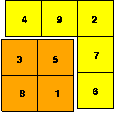
The Pythagoreans explain numerical progressions by successive application of a Gnomon (Rule), shaped like a carpenter's square. In this case, the Square of Saturn is constructed by applying the Gnomon 49276 to the smaller square:
According to the Theory of Balance attributed to 8th century Muslim alchemist Jabir ibn Hayyan (based on 3rd century works by Zosimos and others), the Cosmos and everything in it is made from the numbers 1, 3, 5, 8, 17 and 28; they are the foundation of all matter, of every science, and even of any possible language. The first four numbers were assigned by the Jabirian alchemists to the elements, 1=fire, 3=earth, 5=water, 8=air. The sum of these is 17, which is the fifth number. The Gnomon, which gives the larger square, sums to 4+9+2+7+6 = 28, the sixth number, the second Perfect Number.
Stapleton (Antiq. Alch. 14n24) suggests that the location of 5, the number of water, in the center of the Saturn Square reflects the middle Eastern belief (seen, for example, in Thales and some alchemists) that water is the primary cosmological substance. We have seen, in the interpretation of 19.Angel, how water is the fulcrum used for the rebirth that creates the higher exaltation of the elements.

The Gnomon creates the higher exaltation of the elements, for if the male and female numbers are taken in pairs around the boundary, we get the Element Numbers given by Theodorus of Asine (3rd cent. CE): 9+2 = 11 = fire, 7+6 = 13 = air, 1+8 = 9 = water, 3+4 = 7 =earth (clockwise for decreasing density), which he used to explain the harmony of the elements. The numbers of opposing elements (fire/water, air/earth) add to 20, the quadruple pentad, which combines the two kinds of completion (4 and 5). This balance of the elements refers to 20.Justice, where it is achieved. Naturally, the synthesis of the four elements, which constitute the boundary, yields an eight-fold pentad (40). When the Quintessence (5) is included in the center of the elements, the sum is 45, the thrice divine (3 X 3) exaltation of the pentad. (Stapleton, "Antiq. Alch.," "Gnomon")
Chinese knowledge of the Saturn Square is shown by the ground plan of the Ming-T'ang temple, which was built in A.D. 56. However, as Stapleton (Antiq. Alch. 15) says, "a much greater antiquity for this form of temple is indicated, firstly, by a temple of this plan being essential for Imperial worship, and, secondly, that in the 7th century B.C., during the time of the warring Lords, it was believed to have been used by Wu, the alleged founder of the Chou dynasty in 1025 B.C., when sacrificing to his ancestors. Moreover, if this tradition be correct, the Magic Square form of temple may ultimately be of Scythian origin, introduced at this time from Bactria, or ancient Iran, with the foreign mercenaries from the West, to whose help Wu owed his success in establishing a new dynasty." (From Bactria it may be traceable back to Mesopotamia.)

The Ming-T'ang had twelve stations for the monthly "Proclamation of Space and Time." There is one station for each line segment on the perimeter of the square (or the banner), that is, two for each corner (even) square, one for each side (odd) square. The eight squares on the perimeter represent the eightfold year (3 = vernal equinox, 9 = summer solstice, 7 = autumnal equinox, 1 = winter solstice). The central square corresponds to the additional days of the year beyond the twelve lunar months represented by the twelve line segments of the outer squares. Thus the Son of Heaven visited the central room of the temple (numerically 5, the Emblem of the Center) at "the end of summer - a critical period when the transition was made from the yang seasons to the yin seasons" (Granet, Rel. Ch. 67). Alternately, the twelve line segments of the perimeter can represent the solar year and the zodiac. Thus the representation of Time; the temple also represented Space by assigning 8+3 = east, 4+9 = south, 2+7 = west, 6+1 = north (the same four numbers as the elements, though not the same pairs of squares); opposing directions balance to 20, as do opposing elements. (Granet, Rel. Ch. 66-8; Stapleton, "Antiq. Alch.")
Blofeld (I Ching, 218) says that mankind once understood how the Lo-Shu Square is connected with the (apparently illogical) Later Heaven Sequence of the I Ching, but that it has been forgotten and now only the gods know it. I certainly have not been able to find it. (The connection established by Hacker (41) seems to me to be contrived, although it is remarkable enough that any connection can be established at all.)
19.Angel mirrors many representations of the creation of Pandora (the woman who made possible the humanity of man; see 16.Star). For example, on an ancient vase Pandora is flanked by Aphrodite and Ares (water and fire, love and strife). In other representations her emergence from the earth is facilitated by the craft deities, Athene and Hephaistos. (Bonnefoy, GEM 92, 94; Kerenyi, GG pl. IX)
The disposition of the figures in 19.Angel mirrors that in many alchemical emblems. In illustrations of the Sun and the Moon and the child born of their mystic union, the solar man is most commonly shown on the left and the lunar woman on the right.
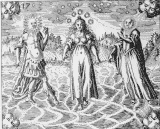

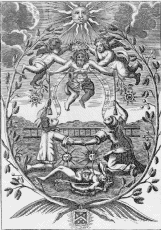
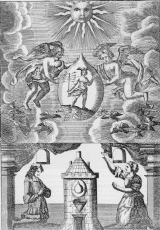
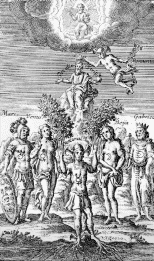
Finally, plate 24 from the 16th century manuscript De Alchimia (de Rola fig. 43) contains a jumble of images associated with 19.Angel and 20.Justice: a woman (active) and man (passive) help a child out of a tub, while an angel looks on; a man, woman and babe emerge from three cauldrons; a woman with a balance is associated with a sword.
The three figures of 19.Angel can also be interpreted as Deukalion, Purrha and one of their children (Hellen, Amphiktuon, Protogeneia). I take the child to be their firstborn, Hellen, because Hellenes take their name from him (a name adopted in 1521 BCE, according to the Parian Chronicle). As to the parents, Deukalion was the son of Prometheus (12.Hanged Man) and Purrha was the daughter of Epimetheus and Pandora (16.Star). (Apollodorus, Bibl. I.vii.2-3)
The twin-peaked mountain with white cliffs is the Gate of the Sun, seen here from the opposite side from that in 7.Temperance and 17.Moon. The Odyssey (24.1-14) tells us how Hermes Psychopompos leads the souls of the dead, gibbering and fluttering like bats, through the Gate of the Sun, over the white cliffs (Leukas) and the dark Ocean, past the Land of Dreams, to the home of the dead.
19.Angel corresponds to the Akkadian god Ea (Sumerian Enki), who was called Great Light of Apsu, that is, the God of the Abyss, which flows above the Underworld. He brings from it the beneficial, rejuvenating water for humanity, and he controls destiny; he holds the Holy Me, the ritual implements which permit communion between people and gods. His mystic number is 60, for he is the son of Anu (21.World), whose mystic number 1 is equivalent to Ea's in the Babylonian sexagesimal number system. Simo Parpola associates Ea with the Sefirah Hokhmah (Wisdom), since Ea was called The Wise, Sage of the Gods, Sage of the Universe, Lord of Wisdom, Lord of Secrets, etc. It is Ea who inaugurates World Order (as told in the story "Enki and the World Order"). (Black & Green s.vv. Enki, me; Parpola 177, 182, 184) (See 17.Moon for the other Sefirot.)
In the practice of yoga, the previous trumps have brought us so far as the Dhyana state (see 18.Sun). In this trump the yogi is called to progress toward Samadhi, Union with the Unus Mundus, wherein one "takes off everything that hides the lordship of the soul" (Vajna Valkya, in Crowley, Bk. 4, Ch. 7), which is reached in 21.World.
 Send comments about this page
Send comments about this page
Last update:
Mon Dec 19, 2022